Effective Stress Site Response Analysis of a Layered Soil Column
Example posted by: Christopher McGann, University of Washington
!!!!UNDER CONSTRUCTION!!!!
This article describes the OpenSees implementation of an effective stress site response analysis of a layered deposit of cohesionless soil underlain by an elastic half-space. A single column of soil is modeled in 2D (with periodic boundary conditions to emulate a 1D analysis) and is subject to an earthquake excitation. Nine node quadrilateral elements with both displacement and pore pressure degrees of freedom enable the model to track changes in pore pressure and effective stress during the earthquake excitation. A Lysmer-Kuhlemeyer (1969) dashpot is utilized to account for the finite rigidity of the underlying elastic medium.
This article also briefly introduces the user to the pre- and post-process visualization tool GiD. Specifically, the means to generate GiD-compatible results from the data returned by the OpenSees recorders are provided and discussed. GiD is a powerful tool for visualizing data and generating meshes, among other things. It is especially helpful when working with 2D and 3D problems in OpenSees. The GiD tool can be downloaded from http://gid.cimne.upc.es/download.
Note: Most of the details of this analysis are identical to those in the Total Stress Site Response Analysis of a Layered Soil Column example posted in the Practical Examples area of this manual. This article will emphasize the attributes which are particular to the effective stress analysis. The user is referred to the total stress example for further information on details which may be omitted or quickly explained here.
Provided with this article are several files. Files which are required for the analysis are indicated. The files include:
- The example input file, freeFieldEffective.tcl (required for analysis)
- The velocity time history of the selected earthquake record, velocityHistory.out (required for analysis)
- A GiD post-process mesh file, freeFieldEffective.flavia.msh (generated automatically by running freeFieldEffective.tcl)
- A Matlab script, flaviaWriter.m, which can be used to reformat the recorded displacement, pore pressure, and stress data into a file which can be read by GiD for post-process visulization. Non-Matlab users may find the process represented by this file useful in creating an alternative means for accomplishing this reformatting.
- The post-process results file, freeFieldEffective.flavia.res, which is generated through the use of the flaviaWriter.m script. This file, combined with the file freeFieldEffective.flavia.msh, allows the user to visualize the results of the site response analysis using GiD.
All of the files mentioned above can be downloaded by clicking here.
To run this example, the user must download the input file, freeFieldEffective.tcl, and the velocity time history file, velocityHistory.out, and place them in a single directory. Once this has been done, the user can then run the analysis. The additional files described above are not essential to the analysis. They are provided to demonstrate how to use the GiD tool to visualize results from this type of analysis.
For further information into a site response analysis using OpenSees, the user is referred to the previously-mentioned total stress site response analysis example and/or the large set of examples developed at the University of California at San Diego available at http://cyclic.ucsd.edu/opensees. These examples utilize a wide variety of element and material formulations, as well as different boundary and loading conditions than those used in this example.
Model Description
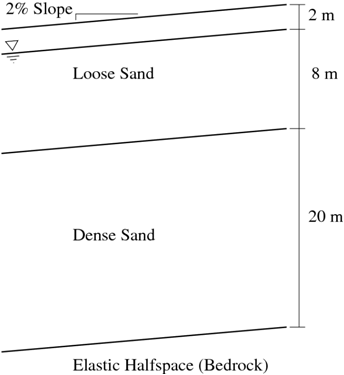
The site response analysis discussed in this article is for a soil profile consisting of a 10 m thick layer of loose sand (Dr = 40%) above a 20 m thick layer of more dense sand (Dr = 75%). The profile is assumed to be on an infinite slope with a 2% grade. A schematic representation of the analyzed soil profile is shown in Fig. 1. The entire soil profile is underlain by an elastic half-space which represents the finite rigidity of an underlying medium such as bedrock. The groundwater table is located at a depth of 2 m, therefore, saturated unit weights are used for the soil below this point and effective stress analysis is considered through the use of nine-node quadrilateral elements which are able to simulate fluid-solid coupling.
Mesh Geometry
The general layout of the model is similar to that discussed in the previously-posted total stress site response analysis example, however, the elements have nine nodes instead of four. A single nine-node element is shown in Fig. 2 to demonstrate the layout of the nodes and the order of element connectivity. The corner nodes (shown in blue in Fig. 2) have three degrees of freedom, two translational and one pore pressure, and the interior nodes (red in Fig. 2) have only two translational degrees of freedom.
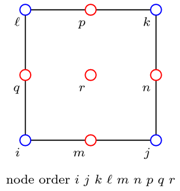
The implementation of the nine node quadrilateral element requires that the two types of nodes, and their corresponding fixities, be created in an appropriate domain. The pore pressure nodes their fixities must be preceded by the command
model BasicBuilder -ndm 2 -ndf 3,
indicating that the domain has 2 dimensions and 3 degrees of freedom. The interior nodes and corresponding fixities must be preceded by the command
model BasicBuilder -ndm 2 -ndf 2,
indicating that the domain has 2 dimensions and 2 degrees of freedom. The node and fixity definitions are the only major aspects of the model for which care must be taken with respect to the domain, however, since the load is applied to a corner node during the dynamic analysis, the correct domain must be redefined prior to the definition of the loading object.
The example analysis provided in the file freeFieldEffective.tcl is set-up in a manner such that the user need only define the geometry of the soil profile and groundwater table (Note: if the ground water table is not located at the surface, an additional soil layer must be included to differentiate the dry or moist soil above the gwt from the saturated soil below the gwt). The nodes are generated automatically based on the input geometry information.
Boundary Conditions
The appropriate boundary conditions are also automatically generated based on the input geometry. The nodes at the base of the soil column are fixed against vertical translation and the pore pressure nodes above the groundwater table are fixed in the pore pressure dof (representing an open drainage condition). Periodic boundary conditions are assumed for the purposes of mimicking a 1D analysis. This is done though the use of the equalDOF command. For the periodic boundary condition, each of the nodes which share the same vertical location are given equal translational degrees of freedom. Note: The pore pressure degrees of freedom for corner nodes at a particular vertical location should not be linked using the equalDOF command. Through the creation of this example, it was found that this can cause problems in the analysis.
Material and Element Definitions
The soil constitutive behavior is modeled using the PressureDependMultiYield02 nDMaterial object. Since no attempt was made to model an actual soil deposit, the material parameters are based upon the recommended table of parameters available on the PressureDependMultiYield02 page for the appropriate relative densities.
Note: The mass density input values for the material objects should be total mass densities, i.e. above the groundwater table, the mass density should reflect dry or moist conditions, and below the groundwater table, the mass density should be the saturated value. For elements with free pore pressure degrees of freedom (those below the water table), the 9_4_QuadUP element computes the effective mass density using the input value from the material object and the fluid mass density specified during the element generation.
Included with the material definitions for each soil layer are additional parameters which are used by the 9_4_QuadUP element. These include the element thickness, the horizontal and vertical body forces on the element, the undrained bulk modulus, and the horizontal and vertical permeabilities. The example is set-up such that these values can vary from layer to layer. The creators of the 9_4_QuadUP element recommend an undrained bulk modulus which is equal to the bulk modulus of the fluid (2.2e6 kPa for water) divided by the porosity of the soil layer. For the layer above the groundwater table, a small value (5e-6 kPa) is used as the undrained bulk modulus.
Note: Gravity must be incorporated into an analysis using the 9_4_QuadUP element in a manner which differs from that used for the standard four node quad element. With the four node quad element, gravity is typically considered through the use of body forces which represent the unit weight of the soil. In the case of the nine node quad element, the body forces should not be the unit weights, instead they should have magnitudes equal to the components of gravity only, i.e. for an analysis of level ground using SI units, the vertical body force should be -9.81 and the horizontal body force should be zero. The infinite slope conditions of this example are modeled by using horizontal and vertical gravity components computed from the angle of the sloping ground as the body forces acting on the elements.
The 9_4_QuadUP elements are created automatically based on the input soil geometry and the material definitions. The 9_4_QuadUP element should be defined in the following manner:
element 9_4_QuadUP eleID nodei nodej nodek nodel nodem noden nodep nodeq noder thickness matID uBulk fMass hPerm vPerm hBody vBody
where uBulk is the undrained bulk modulus, fMass is the fluid mass density, hPerm and vPerm are the horizontal and vertical permeabilites, and hBody and vBody are the horizontal and vertical body forces. The nodal connectivity pattern matches that shown in Fig. 2. In this example, the fluid is water, therefore, the fluid mass density for each layer is set to 1.0 Mg/m^3.
The Lysmer-Kuhlemeyer (1969) dashpot nodes, material, and element are defined as described in the total stress site response analysis example using a bedrock shear wave velocity of 700 m/s and a bedrock mass density of 2.5 Mg/m^3.
Recorders and Analysis
The analysis consists of a gravity stage followed by a dynamic excitation stage. The recorders are separated in to two groups based on the analysis stages. The information recorded by the gravity recorders is useful to confirm that the model has been generated properly and that the appropriate conditions exist prior to the application of the horizontal excitation. A good place to start when working with a new model is the gravity phase. If the model doesn't converge or gives incorrect results under gravity loads, then it can never be expected to work properly in the remainder of the analysis.
The main details of the analysis phases are discussed in the total stress site response analysis example, however, there are several differences which will be discussed here. Due to the way in which this model is constrained, it seems that use of the penalty method works better than the transformation constraints used in the total stress example. The penalty factors specified in the example may need to be adjusted if changes are made to the geometry or parameters. The analysis seemed to run more smoothly using the Krylov-Newton algorithm as opposed to the standard Newton algorithm, however, the user is encouraged to experiment with different algorithms for their analyses. As previously noted above, the domain must be redefined to include three degrees of freedom prior to the definition of the loading object since the node at which the load is applied has three degrees of freedom.
Analysis Results
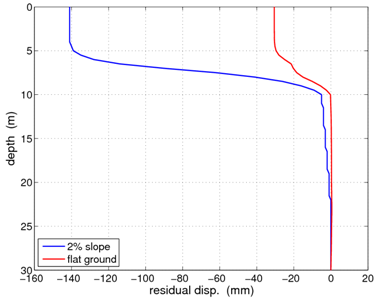
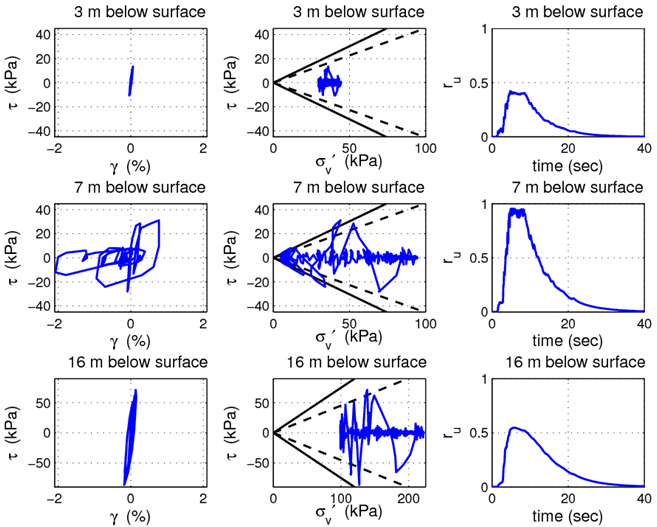
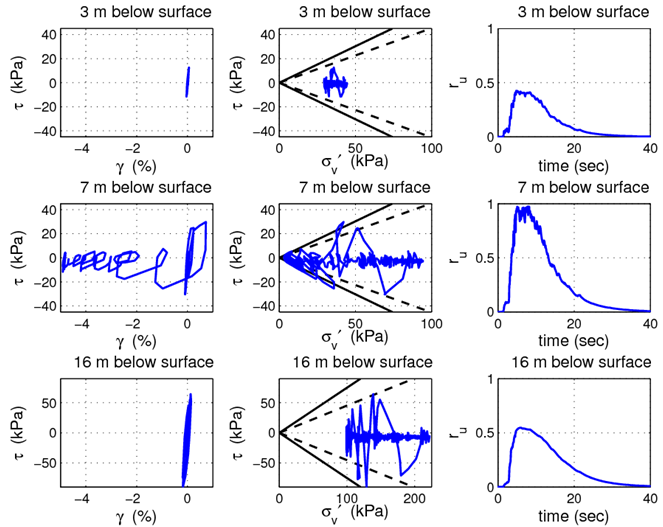
GiD Visualization